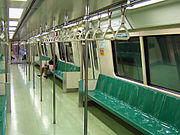Siemens C651
| Siemens AG (SIE) C651 | |
|---|---|

|
|
| In service | 20 September 1994 - present |
| Manufacturer | Siemens AG |
| Built at | Vienna, Austria |
| Constructed | 1993–1994 |
| Refurbishment | Singapore Rail Engineering 2016–2018 |
| Number built | 114 Vehicles (19 Trainsets) |
| Number in service | 108 Vehicles (18 Trainsets) |
| Formation | 6 per trainset DT–M1–M2–M2–M1–DT |
| Fleet numbers | 201/202 ~ 237/238 |
| Capacity | 1920 passengers 372/336 seats |
| Operator(s) | SMRT Trains (SMRT Corporation) |
| Depot(s) | Bishan, Changi, Tuas, Ulu Pandan and East Coast(future) |
| Line(s) served | North South Line and East West Line |
| Specifications | |
| Car body construction | Stainless steel construction |
| Car length | 23 m (75 ft 5 1⁄2 in) |
| Width | 3.2 m (10 ft 6 in) |
| Height | 3.7 m (12 ft 1 5⁄8 in) |
| Doors | 1,450 mm (57 1⁄16 in), 8 per car |
| Maximum speed | 90 km/h (56 mph) (design) 80 km/h (50 mph) (service) |
| Weight | 35 t (34 long tons; 39 short tons) (unladen) 53.8 t (53.0 long tons; 59.3 short tons) (laden) |
| Traction system | Current: GTO–VVVF PWM (Siemens) Replacement: IGBT–VVVF (Toshiba) |
| Traction motors | Current: Three-phase AC induction motor enclosed-ventilated lateral drive 140 kW (190 hp) (Siemens) Replacement: Permanent Magnet Synchronous Motor (Toshiba) |
| Power output | 2.24 MW (3,000 hp) |
| Transmission | 5.94 : 1 Gear Ratio |
| Acceleration | 1.0 m/s (3.3 ft/s) |
| Auxiliaries | 110 V DC |
| Electric system(s) | 750 V DC third rail |
| Current collection method | Collector Shoe |
| UIC classification | 2'2' + Bo'Bo' + Bo'Bo' + Bo'Bo' + Bo'Bo' + 2'2' |
| Braking system(s) | 1st service brake: Self-excited, mixed service and resistor brake 2nd service brake: Pneumatic compressed air wheel tyre block brake Parking brake: Compressed air pressure spring-loaded brake |
| Safety system(s) | Current: Westinghouse Fixed Block ATC with subsystems of ATO GOA 2 (STO), ATP and ATS<br Thales SelTrac® Moving Block CBTC, ATC with subsystems of ATO GOA 3 (DTO), ATP, NetTrac ATS, CBI |
| Track gauge | 1,435 mm (4 ft 8 1⁄2 in) standard gauge |
The Siemens C651, sometimes abbreviated to C651 or SIE C651 is the second generation Electric multiple unit rolling stock in operation on the North South and East West Lines of Singapore's Mass Rapid Transit (MRT) system. A total of 114 cars consisting of 19 train-sets were purchased in 1993 and introduced from 1994 onwards and were built by Siemens in Austria.
The C651 trains are the second generation of train cars used on the SMRT network. It had ordered $259million for the C651 cars. They were bought mainly to complement the existing C151 trains due to the opening of the Woodlands extension. These trains began revenue service in 1994 as the first train-set rolled out of Singapore plant to increase capacity on 17 July 1994 and delivered to SMRT on 20 September 1994. Unlike its older counterparts, the C651s are painted with a scratch-resistant acrylic finish due to dirt trapping on the aluminum skin of the C151 trains that were difficult to remove.
These train cars are fitted with green-blue tinted Glastroch (Germany) windows glass, and are almost identical to the first generation train cars before its refurbishment, except that its traction produces a louder, lower-pitched noise when accelerating/braking. The run number display on the front of each train is made up of electronic green flip-dot display, as opposed to the manual plastic rollers of the Kawasaki Heavy Industries C151 trains, while the rubber strips between the doors are thicker. The trains have a full white body and a thick red stripe in the middle. Similar to the Kawasaki Heavy Industries C151 trains, the Siemens C651 trains have no visual passenger information systems, but have a built-in audio announcement system until the STARIS was installed and activated around 2010.
The C651 trains were originally delivered with a GTO-VVVF propulsion system that was supplied by Siemens. A virtually identical propulsion system would later be used on the Keikyu 2100 series and the JR East E501 series trains.
Many experimental programmes have been run on the C651 cars, including the past program.
...
Wikipedia


